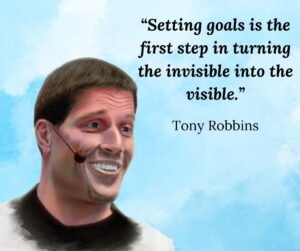Tony Robbins’s statement, “Setting goals is the first step in turning the invisible into the visible,” encapsulates a profound truth about personal growth and achievement. At its core, this idea underscores the power of vision and intentionality in shaping our lives. Goals transform abstract dreams into tangible realities, acting as a bridge between where we are and where we want to be. But how does this process work, and why is it so essential to our success and fulfillment?
The Power of Vision: Why Goals Matter
Every great accomplishment begins with a vision. Vision is the ability to see beyond current circumstances and imagine a better future. It is what inspires inventors to create, entrepreneurs to innovate, and individuals to strive for personal excellence. However, without clear goals, visions often remain just dreams.
Setting goals gives structure to our aspirations. They serve as a roadmap, guiding us through challenges and uncertainties. Goals provide clarity, focus, and a sense of purpose, helping us prioritize our actions and resources.
Imagine trying to build a house without a blueprint. You might have a vague idea of what you want, but without detailed plans, the process would likely be chaotic, inefficient, and incomplete. Similarly, setting goals gives us a framework for turning our abstract desires into concrete outcomes.
The Process of Goal-Setting: From Invisible to Visible
- Dreaming Big
The first step in goal-setting is to dream without limits. What would you accomplish if there were no barriers? This stage is about tapping into your imagination and identifying what truly excites and inspires you. These dreams represent the “invisible”—the ideas and possibilities that currently exist only in your mind. - Defining Your Goals
Dreams become actionable when they are transformed into specific, measurable, achievable, relevant, and time-bound (SMART) goals. For instance, instead of saying, “I want to be healthier,” a SMART goal might be, “I will lose 20 pounds in the next six months by exercising five times a week and eating a balanced diet.” - Visualization and Affirmation
Visualization is a powerful tool that helps bring the invisible closer to reality. When you visualize your goals vividly and repeatedly, you activate your brain's ability to recognize opportunities and resources that align with your objectives. Affirmations, or positive statements about your goals, reinforce your belief in their achievability. - Action and Commitment
Setting goals is only the beginning; taking consistent action is what turns them into reality. Each step you take moves you closer to your destination. Commitment and discipline ensure that you stay on track, even when faced with obstacles. - Tracking Progress
Regularly reviewing your progress keeps you motivated and allows you to adjust your approach if necessary. Celebrating small victories along the way reinforces your belief in your ability to achieve the larger goal.
The Psychology Behind Goal-Setting
Robbins’s message aligns with psychological theories about motivation and goal-setting. Edwin Locke and Gary Latham, pioneers in goal-setting theory, emphasize that specific and challenging goals lead to higher performance than vague or easy ones. Clear goals focus our attention, mobilize effort, and foster persistence.
Additionally, neuroscientists have found that setting goals activates the brain's reward system. When we make progress toward a goal, our brain releases dopamine, a feel-good neurotransmitter that reinforces motivation and encourages us to keep going.
Overcoming Barriers to Goal Achievement
While the concept of setting goals is simple, the journey to achieving them is often fraught with challenges. Common barriers include fear of failure, procrastination, and self-doubt. Recognizing and addressing these obstacles is crucial for success.
- Fear of Failure
Many people hesitate to set ambitious goals because they fear falling short. However, failure is not the opposite of success; it is a stepping stone to growth. Reframing failure as a learning opportunity can help you stay resilient. - Procrastination
Taking the first step can be daunting, especially if your goals seem overwhelming. Breaking your goals into smaller, manageable tasks can make them feel more achievable and reduce the urge to procrastinate. - Self-Doubt
Believing in yourself is essential for goal achievement. Surround yourself with supportive people, practice self-compassion, and remind yourself of past successes to build confidence in your abilities.
The Ripple Effect of Goal-Setting
When you set and achieve goals, the benefits extend far beyond the accomplishment itself. Goal-setting cultivates habits of discipline, focus, and perseverance that spill over into other areas of your life. Moreover, achieving your goals can inspire others, creating a ripple effect of motivation and progress.
For example, a person who sets a goal to run a marathon not only improves their physical fitness but also demonstrates the value of determination and hard work to their friends and family. Their journey may inspire others to pursue their own goals, creating a positive cycle of growth and achievement.
Real-Life Examples of Turning the Invisible into the Visible
History is replete with examples of individuals who turned their dreams into reality through goal-setting. Consider Thomas Edison, who set out to create the electric light bulb. His goal was clear, and despite countless failures, he persevered until his vision became a reality.
Similarly, Oprah Winfrey overcame significant personal and professional challenges to build a media empire. Her success was not a matter of chance; it was the result of setting clear goals, staying focused, and taking consistent action.
On a more personal level, everyday individuals achieve remarkable things by setting and pursuing goals—whether it’s earning a degree, starting a business, or improving their health.
The Role of Reflection and Growth
Achieving a goal is not the end of the journey; it’s an opportunity for reflection and growth. Ask yourself: What did I learn from this experience? How did I grow as a person? What’s next? Setting new goals ensures that you continue to evolve and strive for greater heights.
Conclusion: Embrace the Power of Goals
Tony Robbins’s insight that “setting goals is the first step in turning the invisible into the visible” is a call to action for anyone seeking to create a meaningful life. By setting clear and purposeful goals, you take control of your destiny, transforming dreams into reality and potential into achievement.
The process may not always be easy, but the rewards are immeasurable. As you set and pursue your goals, remember that the journey itself is as important as the destination. Embrace the challenges, celebrate the victories, and never stop dreaming. Through goal-setting, you have the power to turn the invisible into the visible—and to create a life that truly reflects your aspirations and values.


















